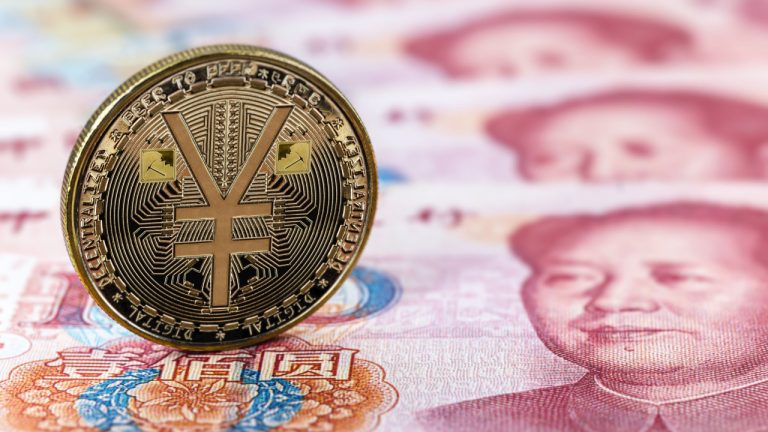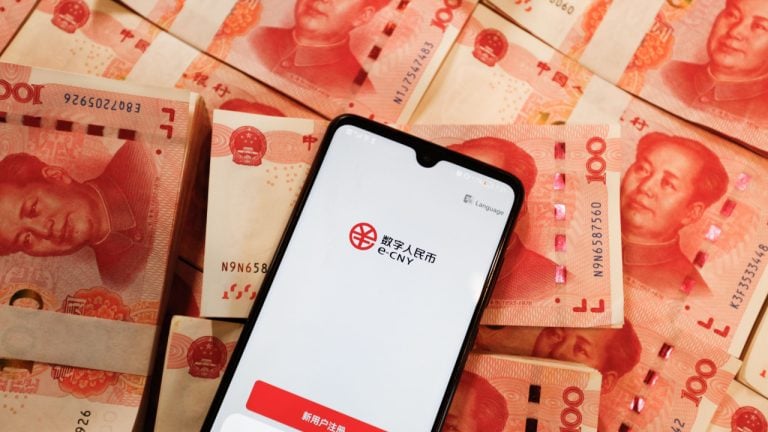 An economics professor and former adviser to the People’s Bank of China has urged the Chinese government to reconsider its ban on cryptocurrencies. He warned that banning crypto activities could result in missed opportunities that are “very valuable” to regulated financial systems. Chinese Economist Warns of Missed Opportunities Due to Crypto Ban A former adviser […]
An economics professor and former adviser to the People’s Bank of China has urged the Chinese government to reconsider its ban on cryptocurrencies. He warned that banning crypto activities could result in missed opportunities that are “very valuable” to regulated financial systems. Chinese Economist Warns of Missed Opportunities Due to Crypto Ban A former adviser […]
China's central bank digital currency (CBDC) has seen new use cases in recent days, including buying securities and making offline payments.
China’s Central Bank Digital Currency (CBDC) — the digital yuan, or eCNY — has received upgrades giving it smart contract functionality alongside a series of newly unveiled use cases.
The smart contract function was launched on the Meituan app, a Chinese app offering retail and food delivery services, according to a Jan. 17 report by local cryptocurrency media outlet 8btc.
When Meituan users place an order and pay with their e-CNY wallet, a smart contract triggers and searches for keywords and purchased items in their order. If a user buys something on the list of keywords for the day, they go in the draw to win part of a prize.
The prize is a share of a “red envelope” known locally as hongbao containing 8,888 yuan, worth a little over $1,300.
Hongbao are small packets traditionally used for gifting money around Chinese New Year as a gesture of good luck.

In December last year, the e-CNY wallet app introduced a feature for users to send digital red envelopes in a bid to boost adoption before the Chinese New Year on Jan. 22.
Alongside the latest development, new uses for the e-CNY have also been added over the last few days.
A Jan. 16 report from the China Securities Journal said e-CNY was used to buy securities for the first time. Investors can also use the CBDC to buy securities with the mobile app for Soochow Securities, a local brokerage firm.
The digital yuan wallet app also received an update with users now able to make contactless payments using Android phones even if their device is without internet or power according to a Jan. 11 Yicai Global report.
The new uses for the digital yuan come as China has been struggling with the adoption rate of its CBDC.
Related: CBDCs not worth the costs and risks, says former BoE advisor
A former official from the People’s Bank of China (PBOC), the country’s central bank, even made a rare public admission in December 2022 saying the digital yuan’s “usage has been low” and “highly inactive” and added, “the results are not ideal.”
On Jan. 10, the PBOC included e-CNY in currency circulation reports for the first time revealing the CBDC represented roughly 0.13% of the 10.47 trillion yuan ($1.54 trillion) in circulation at the end of 2022.

A former China central banker said cumulative e-CNY transactions only crossed $14 billion in two years, adding the results were “not ideal.”
A former official of the People’s Bank of China (PBOC), the country’s central bank, has expressed disappointment that China’s digital yuan is seeing little use.
Xie Ping, a former PBOC research director and current finance professor at Tsinghua University, made critical public comments about China’s central bank digital currency (CBDC) at a recent university conference, according to a Dec. 28 Caixin report.
Xie noted that cumulative digital yuan transactions had only crossed $14 billion (100 billion yuan) in October, two years after launch. “The results are not ideal,” he said, adding that “usage has been low, highly inactive.”
Despite the government’s rapid expansion of the trials and new wallet features to try to attract users, a January PBOC report stated that only 261 million users had set up an e-CNY wallet.
This compares to around 903.6 million people that utilize mobile payments in China, according to a 2021 China UnionPay report.
The former central banker said the use case of e-CNY “needs to be changed” from its current use as a cash substitute and opened to other uses such as the ability to pay for financial products or connected to more payment platforms to boost adoption.
He compared the digital yuan to other third-party payment systems in the country such as WeChat Pay, Alipay, and QQ Wallet, which allow for investments, lending or loans. He said they “have formed a payment market structure that has met needs for daily consumption.”
Some third-party financial apps are e-CNY compatible but see little use, as Xie said “people are used to” using the original service and change “is difficult.”
Such criticism of Chinese government initiatives is rare from former officials and signals the country may be seriously struggling to gain traction on its CBDC initiative.
Related: Over 1,400 Chinese firms operating in blockchain industry, national whitepaper shows
The government has rapidly expanded e-CNY trails most recently in December to four new cities. It was previously expanded in September to Guangdong province, its most populous, and three others.
New features were added to the e-CNY wallet app in a bid to attract users in time for Chinese New Year that added functionality to send digital versions of traditional red packets or red envelopes (hongbao) containing money — a popular custom during festivities.

A traditional Chinese way of gifting money that’s gone virtual with the rise of digital payments has been introduced into the digital yuan wallet app.
China’s wallet app for its digital yuan central bank digital currency (CBDC) introduced a feature for users to send money in an electronic version of traditional “red packets” to try to attract new users.
The new feature was released over the weekend, around one month ahead of the Chinese New Year on Jan. 22, as reported by the South China Morning Post on Dec. 26.
The “red packets,” called hongbao in China, are traditionally used for gifting money around the Chinese New Year and other celebrations as a gesture of good luck. The rising use of digital payments has seen virtual red envelopes offered by popular local services such as WeChat Pay and Alipay.
Reportedly, the e-CNY app allows a red packet to be sent to only one person, or a “lucky draw” can be set up for a group of people who will get a random amount from a pool of funds, both WeChat Pay and Alipay have a similar feature.
Users can choose a packet cover that displays well wishes for the new year or birthdays as well as wishes for a “prosperous China.”
Digital yuan transactions crossed the $14 billion (100 billion yuan) threshold on Oct. 10 seeing an increase of only 14% since the $12 billion (87.6 billion yuan) reported at the end of 2021 by the People's Bank of China.
Related: China floats idea of ‘Asian yuan’ to reduce reliance on US dollar
A Dec.18 report in the Chinese Workers’ Daily newspaper reported the e-CNY trails will expand to the cities of Jinan, Nanning, Fangchenggang and Kunming. The trials previously expanded in September to four of the country’s provinces, including its most populous, Guangdong.
Despite the government’s rapid expansion of the trials, the latest reported user base of the e-CNY wallets was in January 2022, with 261 million users have set up a digital wallet.
China’s government may seemingly have to leverage WeChat Pay and Alipay to boost the adoption of its digital yuan.
Both services accept e-CNY, with WeChat reportedly having 1.3 monthly active users in the September quarter, according to financial reports, while Alipay had over 1 billion annual active users in its fiscal year ending Aug. 17, 2020.
 The Suzhou branch of the Chinese insurance company China Pacific Insurance, together with the Bank of Communications, recently announced the launch of a digital currency account insurance product. The launch comes at a time when the number of personal digital currency wallets created in the Chinese city of Suzhou alone now exceeds 30 million. Insurance […]
The Suzhou branch of the Chinese insurance company China Pacific Insurance, together with the Bank of Communications, recently announced the launch of a digital currency account insurance product. The launch comes at a time when the number of personal digital currency wallets created in the Chinese city of Suzhou alone now exceeds 30 million. Insurance […] According to Yi Gang, governor of China’s central bank, the process of designing the country’s digital currency is premised on two principles, the protection of user privacy as well as ensuring “financial security.” To achieve this, the central bank’s role will be limited to managing the digital currency’s “operating system” while the handling of personal […]
According to Yi Gang, governor of China’s central bank, the process of designing the country’s digital currency is premised on two principles, the protection of user privacy as well as ensuring “financial security.” To achieve this, the central bank’s role will be limited to managing the digital currency’s “operating system” while the handling of personal […] Financial authorities in Hong Kong have unveiled a prototype of the Chinese autonomous territory’s own central bank digital currency called Project Aurum. The two-tier platform features a wholesale interbank and a retail e-wallet system, participants revealed. Hong Kong to Issue Retail Tokens and Stablecoins as Part of Project Aurum A collaboration between the BIS Innovation […]
Financial authorities in Hong Kong have unveiled a prototype of the Chinese autonomous territory’s own central bank digital currency called Project Aurum. The two-tier platform features a wholesale interbank and a retail e-wallet system, participants revealed. Hong Kong to Issue Retail Tokens and Stablecoins as Part of Project Aurum A collaboration between the BIS Innovation […] Spending with China’s state-issued digital currency has surpassed 100 billion yuan, close to $14 billion, by the end of August, the country’s monetary authority revealed. More than 5 million merchants now accept the digital yuan in 15 Chinese regions as Beijing continues to expand the pilot areas. People’s Bank of China Reports 360 Million Digital […]
Spending with China’s state-issued digital currency has surpassed 100 billion yuan, close to $14 billion, by the end of August, the country’s monetary authority revealed. More than 5 million merchants now accept the digital yuan in 15 Chinese regions as Beijing continues to expand the pilot areas. People’s Bank of China Reports 360 Million Digital […] China’s special administrative region of Hong Kong is going to trial а digital version of its dollar as early as this year, in preparation for eventual roll-out. The territory is trying to catch up with those that are already launching central bank digital currencies, including the People’s Republic with its digital yuan project. Trials of […]
China’s special administrative region of Hong Kong is going to trial а digital version of its dollar as early as this year, in preparation for eventual roll-out. The territory is trying to catch up with those that are already launching central bank digital currencies, including the People’s Republic with its digital yuan project. Trials of […] China’s central bank intends to enlarge the area covered by trials of its digital yuan currency in four regions of the country. A top representative of the monetary authority announced the move while highlighting that the People’s Bank has been stepping up digitalization efforts this year. Government to Increase Digital Yuan Coverage in 4 Provinces […]
China’s central bank intends to enlarge the area covered by trials of its digital yuan currency in four regions of the country. A top representative of the monetary authority announced the move while highlighting that the People’s Bank has been stepping up digitalization efforts this year. Government to Increase Digital Yuan Coverage in 4 Provinces […]